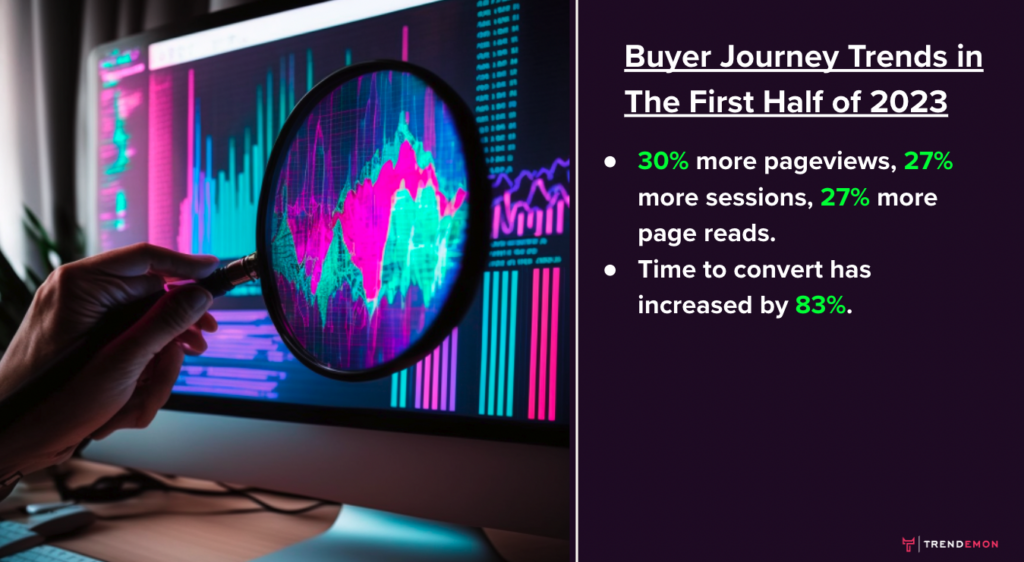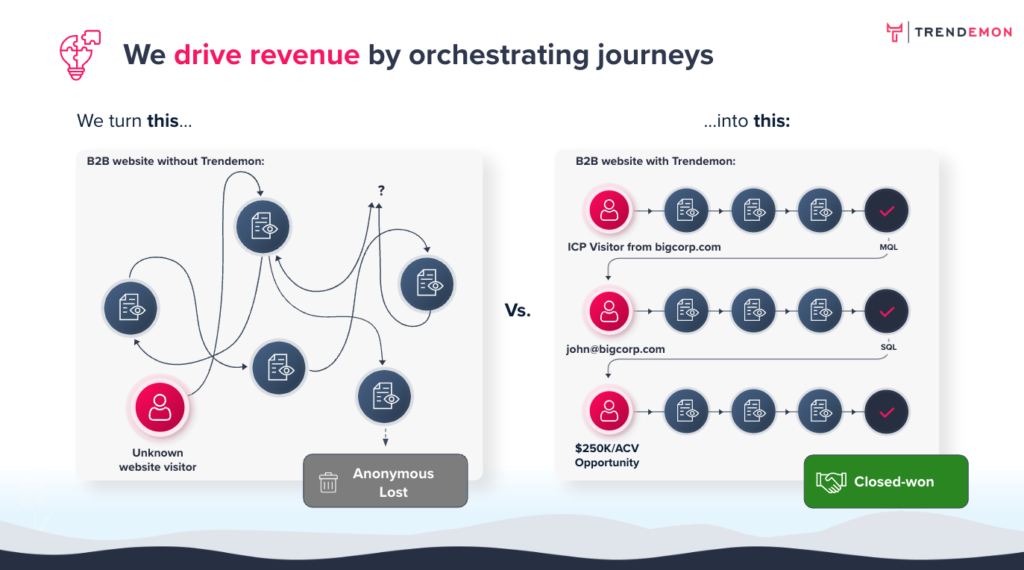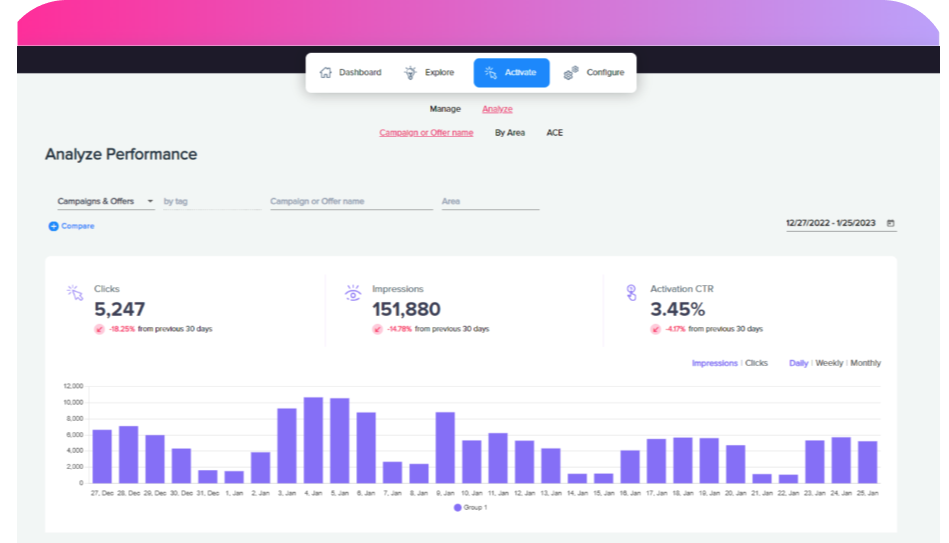Personalized Customer Journey – 101 GUIDE

Imagine this: you walk into a store, and the salesperson greets you by name, knows your preferences, and guides you directly to the products you love. Feels great, right? That’s the magic of a personalized customer journey. Now compare that to walking into a store where no one acknowledges you, and you’re left wandering aimlessly.
Frustrating, isn’t it?
The same thing happens online. A personalized customer journey tailors every step of the user’s experience—showing them relevant content, products, and offers based on their behavior, preferences, and needs. On the other hand, an impersonal journey feels disconnected and generic, leaving customers frustrated and more likely to bounce.
The difference?
Personalization transforms a website into a trusted guide, leading visitors exactly where they want to go while making them feel valued. In this guide, we’ll explore how to craft a seamless, personalized experience that turns casual visitors into loyal customers.
Let’s dive in.
What is a Personalized Customer Journey (and Why It Matters)?
A personalized customer journey is the experience a customer has when every interaction with your brand feels tailored to their needs, preferences, and behaviors. It’s like walking into your favorite coffee shop, where the barista greets you by name and already knows your order. Except, in this case, it’s happening on your website.
Why does it matter? Because today’s customers expect it. A generic, one-size-fits-all journey can leave them feeling overlooked and frustrated. But when you deliver a journey that feels personalized—where every touchpoint resonates with their unique needs—you build trust, engagement, and loyalty.
Benefits of Customer Journey Personalization
- Increased Customer Loyalty: Personalized experiences make customers feel valued, fostering long-term loyalty and repeat business.
- Higher Revenue: Engaged customers are more likely to spend more, boosting sales and overall profitability.
- Improved Retention Rates: Meeting personalized needs reduces churn by keeping customers satisfied and connected to your brand.
- Enhanced Customer Satisfaction: Tailored interactions ensure customers feel understood, building stronger emotional connections.
- Competitive Advantage: Brands that prioritize customer experience personalization stand out in crowded markets, attracting and retaining more customers.
- Better Customer Insights: Personalization requires collecting and analyzing data, helping businesses understand their audience on a deeper level.
Challenges in Implementing Personalization
- Data Privacy Concerns: Customers want personalized digital experiences but demand transparency and security regarding how their data is collected and used.
- Overwhelming Data Volumes: Collecting and analyzing vast amounts of data from purchases, social media, and customer feedback can be resource-intensive without the right tools.
- Siloed Data Systems: Disjointed systems or fragmented data prevent businesses from creating a unified view of the customer, leading to inconsistent personalization efforts.
- Technology Integration: Implementing advanced tools and platforms to support customer personalization can be complex and costly.
- Maintaining Relevance: Delivering consistently relevant and timely personalized experiences requires continuous refinement and monitoring of customer preferences.

How to Collect and Analyze Customer Data Effectively
Creating a personalized customer journey starts with understanding your audience—and that requires data. Here’s how to collect and analyze customer data like a pro:
- Tap Into Multiple Sources:
Gather data from all key touchpoints: website interactions, social media, purchase history, email engagement, and customer support. Each source adds a piece to the puzzle of understanding your customers. - Use the Right Tools:
Leverage tools like Google Analytics for website behavior, CRM systems for purchase data, and Customer Data Platforms (CDPs) to centralize everything. A unified view of the customer is essential for effective personalization. - Segment Your Audience:
Once you’ve collected data, organize it into meaningful segments based on behaviors, preferences, and demographics. For example, group customers by purchase frequency or product categories they browse. - Turn Data into Insights:
Analyze patterns to identify opportunities for personalization. For instance, notice customers abandoning their carts? Tailor your messaging to address common hesitations.
Tactics for Tailoring Content and Offers
Personalization isn’t just about gathering data—it’s about acting on it. Here are some practical ways to tailor your content and offers:
- Personalized Product Recommendations:
Use AI-powered tools to suggest products based on browsing and purchase history. For example, show “Customers also bought” suggestions to cross-sell complementary items. - Dynamic Email Campaigns:
Create emails that adapt to the recipient’s actions. If a customer browses a specific product but doesn’t buy, follow up with a reminder or discount tailored to that item. - Custom Landing Pages:
Build landing pages tailored to specific customer segments. For instance, a page highlighting kid-friendly products for parents or a business-focused page for B2B buyers. - Exclusive Offers and Discounts:
Reward loyalty with personalized discounts or early access to sales. Use behavioral triggers, like offering a discount after a customer views the same product multiple times.
Steps to Deliver Personalized Customer Experiences
Step 1: Aggregate Customer Data
To create a truly personalized customer journey, you first need to collect and analyze customer data. This includes data from touchpoints like social media, website interactions, and purchase history.
By gathering information from these sources, businesses can better understand customer preferences, habits, and needs. For example, analyzing purchase history helps predict future buying behavior, while social media data can reveal interests and engagement patterns.
The goal is to build a complete picture of each customer, enabling a more tailored and impactful experience. Without a strong foundation of accurate data, personalization efforts can miss the mark.
Step 2: Segment Your Customer Base
Not all customers are the same, and treating them as such undermines personalization. To deliver value, businesses must group customers based on shared traits like behaviors, demographics, or preferences.
This segmentation allows brands to focus on the individual customer within specific groups, addressing their personalized needs more effectively. For instance, high-value customers might receive VIP offers, while first-time buyers might get onboarding tips.
The result? More meaningful customer interaction that feels relevant and personalized. Segmentation transforms data into actionable insights, making personalization scalable.
Step 3: Reach Customers at the Right Touchpoints
Timing is everything in personalization. Mapping customer journeys helps identify the most effective touchpoints to personalize the experience.
Every interaction with your brand, whether through email, social media, or in-store visits, offers an opportunity to deliver personalized messaging. For example, sending a discount code right after a cart abandonment email can nudge a customer back to complete their purchase.
By understanding where and when customers engage, businesses can align their outreach to customer expectations, ensuring relevance and impact. This approach keeps customers engaged and fosters stronger relationships.
Step 4: Engage Customers with Relevant Content
Content is king, but relevance is its crown. Delivering a personalized product experience requires tailoring content like personalized product recommendations and personalized offers to individual preferences.
For example, suggesting complementary products based on a customer’s past purchases or browsing behavior creates a seamless personalized shopping experience. Similarly, dynamic email campaigns that adjust to customer actions can boost engagement.
This level of customization not only improves satisfaction but also encourages higher conversions. When you personalize offers, you show customers that you understand their needs—making them more likely to choose your brand.
Step 5: Continuously Collect Data
Personalization isn’t a one-and-done effort. Businesses need to continuously gather customer feedback and analyze how well their personalization efforts are working.
By tracking what works and what doesn’t, businesses can adjust their strategies to meet evolving customer needs. For example, if a product recommendation engine shows declining click-through rates, tweaking the algorithm can reignite engagement.
This iterative approach ensures that individual customer preferences are always at the heart of your personalization strategy. Continuous refinement leads to stronger, more effective personalization over time, keeping your brand aligned with customer expectations.
Real-Life Examples of Brands Delivering Personalized Experiences
- Amazon: Personalized Shopping at Scale
Amazon is a master of personalized shopping experiences. By leveraging customer data like browsing history and past purchases, the company provides tailored product recommendations that feel spot-on. Their “frequently bought together” and “recommended for you” features ensure customers feel their needs are understood, making shopping seamless and efficient. - Netflix: Custom-Tailored Content Suggestions
Netflix’s algorithm takes customer personalisation to the next level. Based on viewing habits, ratings, and search behavior, Netflix curates a unique library for every user. This level of personalized attention keeps users engaged and ensures they’re always discovering content they love. - Sephora: Personalized Beauty Assistance
Sephora combines personalized customer service with cutting-edge technology. Through its app, customers receive tailored beauty product suggestions based on their skin type, preferences, and past purchases. The brand also offers virtual try-ons and AI-driven advice, giving customers the feeling of a one-on-one consultation.
Tools and Technologies for Personalization
Creating a personalized digital experience requires the right tools to manage data, analyze behavior, and deliver tailored interactions. Here are a few platforms leading the way:
- Customer Data Platforms (CDPs) like Segment:
CDPs unify customer data from various sources—such as websites, social media, and email—into a single profile. This creates a comprehensive view of the customer, allowing businesses to tailor every interaction based on real-time insights. - AI-Powered Personalization with Dynamic Yield:
Dynamic Yield uses artificial intelligence to deliver real-time product recommendations, personalized website experiences, and dynamic email content. Its ability to adapt based on customer behavior ensures every touchpoint feels relevant. - Content Personalization with Trendemon:
Trendemon.com specializes in mapping customer journeys and optimizing content engagement. By analyzing visitor behavior, Trendemon suggests the most impactful content for each stage of the journey, boosting conversions and ROI. Businesses benefit from actionable insights into how content drives revenue and deeper customer connections.
The Power of Website Journey Optimization:
Optimizing the website journey involves mapping out the entire user experience from the first touchpoint to the final conversion. This holistic approach enables businesses to create a seamless flow of content and information tailored to the needs of each persona at every stage of their journey. By presenting the right content, in the right sequence, businesses can nurture leads and guide them towards conversion effectively.

Stringing Together Engaging Content Pieces:
Instead of relying solely on individual pages to engage users, a journey-focused optimization strategy strings together engaging content pieces to form a Content Stream. For example, a blog post could lead to a downloadable eBook, which, in turn, directs the user to a webinar or a demo request. This interconnected approach encourages visitors to explore more content, nurturing their interest and building trust in your brand.

Personalization for Enhanced User Experience:
A key advantage of optimizing the entire journey is the ability to personalize content based on a user’s interactions and preferences. Personalization creates a sense of relevance and makes users feel understood, which can significantly impact their decision-making process. By leveraging data from multiple touchpoints, businesses can deliver targeted content that speaks directly to each persona’s pain points and aspirations.
Driving Conversion with Journey Optimization:
Ultimately, the goal of any B2B website is to drive conversions. A well-optimized website journey guides users through each stage of the buyer’s journey, building a relationship and ultimately leading them towards making a purchase or taking the desired action. This approach increases the likelihood of converting leads into loyal customers, positively impacting the bottom line.
Embracing Analytics and Iterative Improvements:
Website journey optimization involves continuous improvement based on real-time data and analytics. Businesses can track user behavior, identify drop-off points, and test different content variations to refine the journey continually. This iterative process ensures that the website remains aligned with evolving user needs, technological advancements, and business

Measuring the Impact of Personalization
Delivering a personalized customer experience is just the first step; measuring its success is where the real value lies. Businesses can evaluate the effectiveness of their personalization efforts using key performance indicators (KPIs) that highlight customer satisfaction, engagement, and overall impact.
- Customer Retention Rates: A strong indicator of success is whether customers keep coming back. Personalization meets personalized needs, fostering loyalty and reducing churn.
- Customer Feedback: Surveys, reviews, and direct feedback provide insights into how customers perceive their experiences. Positive responses suggest your efforts are hitting the mark, while constructive criticism helps refine your approach.
- ROI of Personalization Efforts: Tracking revenue generated through tailored recommendations, targeted campaigns, or dynamic content shows how personalization contributes to the bottom line. For example, measuring the uplift in sales from personalized product recommendations can directly link personalization to profits.
Conclusion
A well-executed personalized customer experience is no longer optional—it’s a business imperative. Customers today expect brands to understand their unique needs and preferences, rewarding those that deliver with loyalty, repeat business, and advocacy.
By prioritizing personalization efforts, businesses can forge deeper connections, stand out in competitive markets, and drive measurable results like increased retention and revenue. The key lies in understanding your audience, leveraging the right tools, and continually refining strategies based on customer feedback.
As customer expectations evolve, so must your approach to personalization. Staying adaptable and focused on delivering value at every touchpoint ensures your business remains relevant, trusted, and successful in the long run. It’s time to embrace personalization not just as a strategy, but as a cornerstone of exceptional customer experiences.